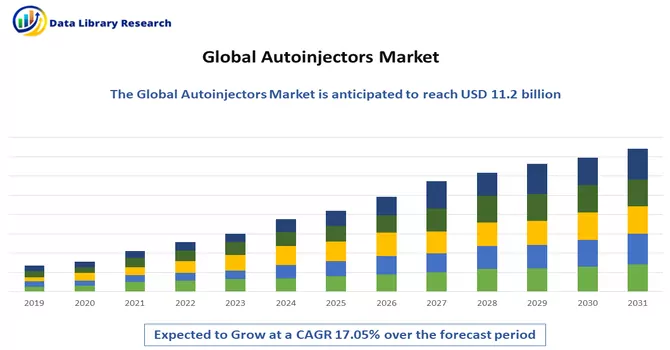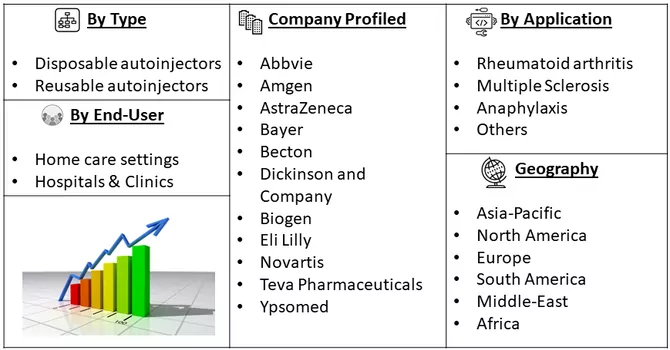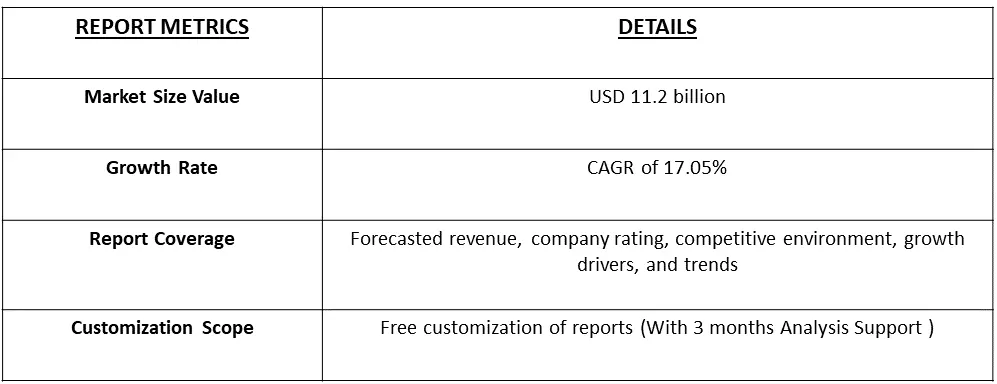The Global Auto-Injectors Market size is estimated at USD 11.2 billion in 2023 and is expected to reach a CAGR of 17.05% during the forecast period (2024-2031).

Get Complete Analysis Of The Report - Download Free Sample PDF
An autoinjector is a medical device designed to administer a pre-measured dose of a medication, typically in liquid form, through a needle, subcutaneously or intramuscularly. The device is designed to be user-friendly, allowing individuals to self-administer medication easily. Autoinjectors are commonly used for the delivery of certain medications, such as epinephrine for severe allergic reactions, insulin for diabetes, and various other injectable drugs. They often feature a spring-loaded mechanism to quickly and safely deliver the medication, and many are designed for single-use, disposable applications. Autoinjectors are intended to provide a convenient and efficient means of drug administration, especially for individuals who may need to administer medication outside of a healthcare setting.
The autoinjectors market is experiencing robust growth driven by several key factors. The escalating prevalence of chronic diseases, including diabetes, rheumatoid arthritis, and multiple sclerosis, has propelled the demand for autoinjectors as they offer a convenient and user-friendly method for self-administration of medications. Patient preferences for at-home self-administration, especially among the aging population, contribute to increased treatment adherence and improved disease management. Advances in drug delivery technologies, such as enhanced safety features and ergonomic designs, further enhance the appeal of autoinjectors. Regulatory approvals for an expanding array of medications compatible with autoinjectors, along with a growing focus on patient-centric healthcare, underscore the market's expansion. Additionally, the integration of electronic components and connectivity features in smart autoinjectors aligns with the broader trend of technological advancements in healthcare. Collectively, these factors drive the adoption and acceptance of autoinjectors across diverse therapeutic applications, making them a pivotal component in the evolving landscape of drug delivery systems.
Market Segmentation: The Global Autoinjector Market is Segmented by Application (Rheumatoid Arthritis, Multiple Sclerosis, Anaphylaxis, and Others), and Geography (North America, Europe, Asia-Pacific, Middle East, and Africa, and South America). The market provides the value (in USD million) for the above-mentioned segments.

For Detailed Market Segmentation - Download Free Sample PDF
The autoinjector market is witnessing notable trends that shape its trajectory in the healthcare landscape. One significant trend is the increasing focus on patient-centric design and usability enhancements. Manufacturers are prioritizing ergonomic and user-friendly designs to enhance the overall patient experience during self-administration of medications. Integration of features such as intuitive user interfaces, audible cues, and visual indicators aims to simplify the process and improve patient adherence. Another noteworthy trend is the proliferation of smart autoinjectors. These devices incorporate electronic components and connectivity features to provide real-time data and connectivity to healthcare providers. Smart autoinjectors enable remote monitoring of patient adherence, dosing schedules, and therapy outcomes, contributing to more personalized and data-driven healthcare. Furthermore, the market is witnessing advancements in needle safety technologies, with the development of autoinjectors that incorporate retractable and shielded needles. This addresses concerns related to needlestick injuries and enhances overall safety for both patients and healthcare providers. The expansion of the autoinjector market is also driven by a broader regulatory landscape. Increasing approvals for new drug formulations compatible with autoinjectors contribute to the market's growth. Additionally, partnerships and collaborations between pharmaceutical companies and autoinjector manufacturers are fostering innovation and expanding the range of therapeutic options available for self-administration. Overall, these trends underscore the dynamic nature of the autoinjector market, reflecting a continuous effort to improve patient outcomes, enhance safety, and embrace technological advancements in drug delivery systems.
Market Drivers:
Increasing Demand for Convenience of Patients
The autoinjector market is experiencing a surge in demand driven by the growing emphasis on convenience for patients. This trend is particularly pronounced in the healthcare landscape, where patients increasingly prefer self-administration of medications in the comfort of their homes. Autoinjectors play a pivotal role in meeting this demand by offering a user-friendly and convenient solution for patients managing chronic conditions. The convenience factor associated with autoinjectors lies in their easy-to-use design, enabling patients to self-administer medications without the need for healthcare professionals. This not only empowers patients but also enhances their overall treatment adherence. The simplicity of autoinjectors, often featuring one-touch mechanisms and pre-filled cartridges, streamlines the administration process, making it more accessible for individuals of varying ages and health conditions. The demand for convenience is especially prominent among patients with chronic diseases such as rheumatoid arthritis, multiple sclerosis, and diabetes. Autoinjectors provide a reliable and efficient means for these patients to administer prescribed medications at the required dosage without the complexity of traditional injection methods. Furthermore, the increasing prevalence of at-home healthcare and the desire for more patient-centric solutions contribute to the growing adoption of autoinjectors. As manufacturers focus on designing devices with improved usability and incorporating advanced features, the market is poised to meet the rising demand for convenience among patients seeking a seamless and hassle-free self-administration experience. In essence, the symbiotic relationship between the increasing demand for convenience and the expanding autoinjector market reflects a transformative shift in patient care and medication management practices.
Rising Incidence of Chronic and Lifestyle Diseases
The rising incidence of chronic and lifestyle diseases has become a significant driving force behind the growing adoption of autoinjectors in the healthcare landscape. Chronic conditions, such as rheumatoid arthritis, multiple sclerosis, and diabetes, are becoming increasingly prevalent globally, necessitating efficient and convenient methods of medication administration. Autoinjectors play a crucial role in addressing the needs of patients with chronic diseases by offering a user-friendly and self-administration solution. The convenience and simplicity of autoinjectors make them an attractive option for individuals managing long-term health conditions, as these devices facilitate precise and controlled delivery of medications without the need for professional assistance. Patients with chronic diseases often require frequent and precise dosage administration, and autoinjectors provide a reliable mechanism for achieving this. The ease of use associated with autoinjectors empowers patients to self-administer medications at home, fostering independence and improving overall treatment adherence. Moreover, lifestyle factors contribute to the increasing incidence of chronic diseases, with sedentary lifestyles, poor dietary habits, and other environmental factors playing a role. As these lifestyle-related health issues continue to rise, the demand for effective and accessible drug delivery methods like autoinjectors is expected to grow. The adaptability of autoinjectors to various therapeutic areas, coupled with ongoing advancements in their design and functionality, positions them as a preferred choice for patients and healthcare providers alike. The intersection of the rising prevalence of chronic and lifestyle diseases with the convenience offered by autoinjectors underscores the crucial role these devices play in modern healthcare, providing a valuable tool for enhanced patient care and improved disease management.
Market Restraints:
Regulatory Hurdles
The autoinjectors market faces regulatory hurdles that have the potential to impede its growth trajectory. Regulatory challenges encompass a range of factors, including stringent approval processes, evolving compliance standards, and variations in regulatory requirements across different regions. Obtaining regulatory approval for autoinjectors involves rigorous assessments to ensure product safety, efficacy, and adherence to quality standards. Regulatory authorities, such as the U.S. Food and Drug Administration (FDA) and the European Medicines Agency (EMA), impose stringent criteria for the approval of medical devices, including autoinjectors. Meeting these criteria can be time-consuming and resource-intensive for manufacturers, leading to delays in product launches and market entry. The evolving nature of regulatory standards adds another layer of complexity to the autoinjectors market. As regulatory bodies update and refine their guidelines, manufacturers must adapt to stay in compliance. Keeping pace with these dynamic regulatory landscapes requires significant investments in research, development, and regulatory affairs.
The healthcare industry has experienced both positive and negative effects due to the COVID-19 pandemic, and these effects have extended to the market for autoinjectors. Notably, autoinjector products, often self-administered by patients at home, have offered a favorable solution amid the pandemic. Patients relying on autoinjectors can continue their treatment without the need to venture outside, aligning with the imperative of maintaining social distancing measures. However, the surge in COVID-19 cases has strained hospital resources and the availability of medical supplies, including injections and pre-filled syringes. Manufacturers have responded by scaling up production to meet the heightened demand, illustrating the pandemic's profound impact on the autoinjector market as it adapts to the evolving healthcare landscape.
Segmental Analysis:
Rheumatoid arthritis (RA) is poised to hold a substantial market share over the forecast period in the field of autoinjectors. RA, an autoimmune disease causing joint inflammation and pain, primarily affects the elderly, with a notable prevalence among females. The global elderly population, expected to double by 2050, is contributing to the increased incidence of arthritis, particularly in the geriatric demographic. Studies indicate that patients with RA using autoinjectors experience enhanced comfort and better outcomes, fostering the growth of this segment. Market players' initiatives, such as NORDIC PHARMA's submission of a New Drug Submission for the methotrexate auto-injector, Nordimet, further drive the market's expansion. Anticipated approvals for such drugs are poised to fuel growth in the autoinjectors market segment.
North America is anticipated to dominate the global disposable auto-injectors market, driven by factors such as early adoption of technologically advanced products, product approvals, and the increasing prevalence of chronic diseases in the region. The high incidence of diseases like cancer contributes significantly to market growth. In 2020, the United States reported 2,281,658 new cancer cases, with 612,390 deaths, highlighting the pressing need for advanced medical solutions. Additionally, the region experiences continuous growth through technological advancements, the entry of new players, and rapid adoption of innovative products. For instance, Teva Pharmaceuticals USA, Inc., introduced an autoinjector device for AJOVY in April 2020, offering a preventive treatment for migraines in adults. The availability of such advanced solutions is expected to drive the North American disposable auto-injectors market over the forecast period.

Get Complete Analysis Of The Report - Download Free Sample PDF
The analyzed market exhibits a high degree of fragmentation, primarily attributable to the presence of numerous players operating on both a global and regional scale. The competitive landscape is characterized by a diverse array of companies, each contributing to the overall market dynamics. This fragmentation arises from the existence of specialized solution providers, established industry players, and emerging entrants, all vying for market share. The diversity in market participants is underscored by the adoption of various strategies aimed at expanding the company presence. On a global scale, companies within the studied market are strategically positioning themselves through aggressive expansion initiatives. This often involves entering new geographical regions, targeting untapped markets, and establishing a robust global footprint. The pursuit of global expansion is driven by the recognition of diverse market opportunities and the desire to capitalize on emerging trends and demands across different regions. Simultaneously, at the regional level, companies are tailoring their approaches to align with local market dynamics. Regional players are leveraging their understanding of specific market nuances, regulatory environments, and consumer preferences to gain a competitive edge. This regional focus allows companies to cater to the unique needs of local clientele, fostering stronger market penetration. To navigate the complexities of the fragmented market, companies are implementing a range of strategies. These strategies include investments in research and development to stay at the forefront of technological advancements, mergers and acquisitions to consolidate market share, strategic partnerships for synergies, and innovation to differentiate products and services. The adoption of such multifaceted strategies reflects the competitive nature of the market, with participants continually seeking avenues for growth and sustainability. In essence, the high fragmentation in the studied market not only signifies the diversity of players but also underscores the dynamism and competitiveness that drive ongoing strategic manoeuvres. As companies explore various avenues for expansion, the market continues to evolve, presenting both challenges and opportunities for industry stakeholders. Some of the key market players working in this segment are:
Recent Development:
1) In May 2022, Jabil Healthcare, a division of Jabil Inc., introduced the Qfinity autoinjector platform—a cost-effective, reusable, and modular solution designed for the self-administration of subcutaneous (SC) drugs. This innovative autoinjector aims to provide users with a straightforward and user-friendly experience, presenting a viable alternative to existing options in the market.
2) In May 2022, Stevanato Group S.p.A. entered into an exclusive agreement with Owen Mumford Ltd., a prominent medical device developer and manufacturer, for the distribution of the Aidaptus auto-injector. This collaboration signifies a strategic move to enhance the accessibility and availability of the Aidaptus auto-injector in the market. These developments reflect the industry's commitment to advancing drug delivery technologies, offering patients more options for convenient and efficient self-administration of medications.
Q1. What was the Autoinjectors Market size in 2023?
As per Data Library Research the Autoinjectors Market size is estimated at USD 11.2 billion in 2023.
Q2. At what CAGR is the Autoinjectors Market projected to grow within the forecast period?
Autoinjectors Market is expected to reach a CAGR of 17.05% during the forecast period.
Q3. What are the factors driving the Autoinjectors Market?
Key factors that are driving the growth include the Increasing Demand for Convenience of Patients and Rising Incidence of Chronic and Lifestyle Diseases.
Q4. Which Region is expected to hold the highest Market share?
North America region is expected to hold the highest Market share.
Data Library Research are conducted by industry experts who offer insight on industry structure, market segmentations technology assessment and competitive landscape (CL), and penetration, as well as on emerging trends. Their analysis is based on primary interviews (~ 80%) and secondary research (~ 20%) as well as years of professional expertise in their respective industries. Adding to this, by analysing historical trends and current market positions, our analysts predict where the market will be headed for the next five years. Furthermore, the varying trends of segment & categories geographically presented are also studied and the estimated based on the primary & secondary research.
In this particular report from the supply side Data Library Research has conducted primary surveys (interviews) with the key level executives (VP, CEO’s, Marketing Director, Business Development Manager and SOFT) of the companies that active & prominent as well as the midsized organization
FIGURE 1: DLR RESEARH PROCESS

Extensive primary research was conducted to gain a deeper insight of the market and industry performance. The analysis is based on both primary and secondary research as well as years of professional expertise in the respective industries.
In addition to analysing current and historical trends, our analysts predict where the market is headed over the next five years.
It varies by segment for these categories geographically presented in the list of market tables. Speaking about this particular report we have conducted primary surveys (interviews) with the key level executives (VP, CEO’s, Marketing Director, Business Development Manager and many more) of the major players active in the market.
Secondary ResearchSecondary research was mainly used to collect and identify information useful for the extensive, technical, market-oriented, and Friend’s study of the Global Extra Neutral Alcohol. It was also used to obtain key information about major players, market classification and segmentation according to the industry trends, geographical markets, and developments related to the market and technology perspectives. For this study, analysts have gathered information from various credible sources, such as annual reports, sec filings, journals, white papers, SOFT presentations, and company web sites.
Market Size EstimationBoth, top-down and bottom-up approaches were used to estimate and validate the size of the Global market and to estimate the size of various other dependent submarkets in the overall Extra Neutral Alcohol. The key players in the market were identified through secondary research and their market contributions in the respective geographies were determined through primary and secondary research.
Forecast Model
